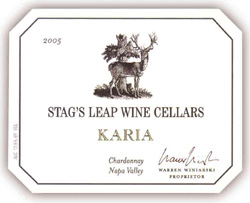

Stag's Leap Wine Cellars
2005 Karia Chardonnay(Napa Valley)
This is the baby sister to Stag’s Leap’s more expensive and established Arcadia Chardonnay. Karia – Greek for graceful – is all that, but in its coming out, this debutante isn’t there yet, but she has great potential. Right now, she’s only in her infancy. Rounder and fuller than its sibling, the Karia (CAR-ee-a) is showing tropical fruit notes and a potential for elegance. All in all though, it exhibits the balanced acidity that is so prevalent in the Arcadia.
A preponderance of the fruit (65%) comes from the Arcadia Vineyard in the Coombsville area in the eastern hills above the city of Napa, while the rest comes from the winery’s Stags Leap District estate vineyard.
As with the Arcadia, a portion (9% as compared to 35%) of the Karia was fermented in stainless steel tanks. Thirty percent of the remainder saw new French oak (compared to no new oak for the Arcadia). Twenty-eight percent of the juice was introduced to malolactic fermentation (compared to 15% for the Arcadia), and the listed alcohol is still a very reasonable 13.5 percent (as compared to only 12.8 percent for the Arcadia).
I was flabbergasted to learn that there were 20,000 cases of this wine produced. You don’t see so much wine given this much attention and detail. Give this one some time and Karia may grow up to give her big sister a sibling rivalry for the ages.
Reviewed October 19, 2006 by Alan Goldfarb.
Other reviewed wines from Stag's Leap Wine Cellars
|
Stag's Leap Wine Cellars 2003 Cabernet Sauvignon , FAY (Stags Leap District ~ Napa Valley)Alan Goldfarb 10/24/2006 |
The Wine
Winery: Stag's Leap Wine Cellars |
The Reviewer Alan Goldfarb
Alan Goldfarb
Alan Goldfarb has been writing about and reviewing wine for 17 years. His reviews have been published in the St. Helena Star, San Jose Mercury, San Francisco Examiner, Decanter, and Wine Enthusiast, among others. Not once has he used a point system, star system, or an iconic symbol to quantify a wine. What counts in Mr. Goldfarb’s criteria when judging a wine is: how it tastes in the glass; is it well-constructed; its food compatibility; and presence of redeeming regional attributes. |












